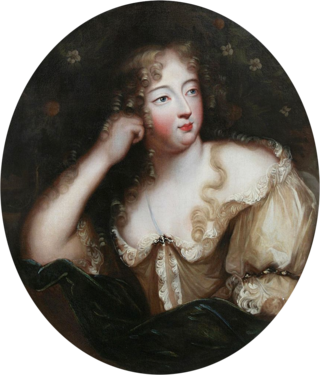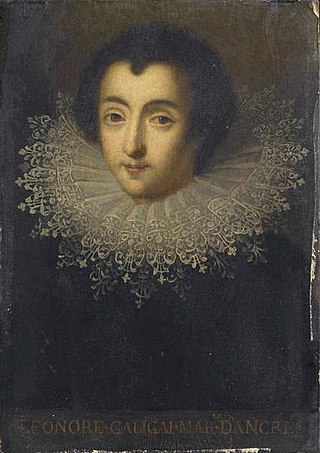Related Research Articles

Gabrielle d'Estrées, Duchess of Beaufort and Verneuil, Marchioness of Monceaux was a mistress, confidante and adviser of Henry IV of France. She is noted for her role in ending the religious civil wars that plagued France for more than 30 years.

Françoise-Athénaïs de Rochechouart de Mortemart, Marquise of Montespan was the most celebrated maîtresse-en-titre of King Louis XIV, by whom she had seven children.

A Parc-aux-Cerfs, in France, was generally the name given to the clearings that provided hunting fields for the French aristocracy prior to the French Revolution. The name is most notoriously known in history for an area in the grounds of the Palace of Versailles and a house there owned by Louis XV, where his secret mistresses were accommodated, being taken from there to the palace to visit the king.

The maîtresse-en-titre was the chief royal mistress of the King of France. The title was vaguely defined and used in the Middle Ages but finally became an acknowledged office during the reign of Henry IV and continued through the reign of Louis XV. It was a semi-official position which came with its own apartments, estates and a title if the woman did not have any. The position could come with significant power, even more influence than the Queen of France, as some mistresses were known to advise the King of France sometimes in state affairs if he was so infatuated, broker favors for clients, elevate others in social mobility, forge alliances and negotiate with foreign diplomats all the while supplying the king his emotional and physical needs at the same time enriching themselves in the relationship. In contrast, the title petite maîtresse was the title of a mistress who was not officially acknowledged.

The House of Bourbon-Penthièvre was an illegitimate branch of the House of Bourbon, thus descending from the Capetian dynasty. It was founded by the duc de Penthièvre (1725–1793), the only child and heir of the comte de Toulouse, the youngest illegitimate son of Louis XIV of France and the marquise de Montespan, and his wife, Marie Victoire de Noailles, the daughter of Anne Jules de Noailles, duc de Noailles.

A prince du sang or prince of the blood is a person legitimately descended in male line from a sovereign. The female equivalent is princess of the blood, being applied to the daughter of a prince of the blood. The most prominent examples include members of the French royal line, but the term prince of the blood has been used in other families more generally, for example among the British royal family and when referring to the Shinnōke in Japan.

Louise Françoise, Duchess of Bourbon was the eldest surviving legitimised daughter of Louis XIV of France and his maîtresse-en-titre Françoise-Athénaïs, Marquise de Montespan. She was said to have been named after her godmother, Louise de La Vallière, the woman her mother had replaced as the king's mistress. Before her marriage, she was known at court as Mademoiselle de Nantes.

Marie Victoire Sophie de Noailles, Countess of Toulouse, was a French noble and courtier. Her second spouse was Louis Alexandre de Bourbon, Count of Toulouse, the youngest legitimized son of King Louis XIV of France and his maîtresse-en-titre, Madame de Montespan.

If Paris Were Told to Us is a 1956 French historical film directed and written by Sacha Guitry. The admissions in France were 2,813,682 people.
Louise de Maisonblanche, was a French noblewoman, the illegitimate daughter of Louis XIV, King of France and his mistress, Claude de Vin des Œillets. She became the Baroness of La Queue by her marriage to Bernard de Prez.

Baroness Francoise Charlotte Amable d'Aubigne-Maintenon, Duchess of Noailles was a French aristocrat, the wife of Adrien Maurice de Noailles, 3rd Duke of Noailles. She was the niece of Françoise d'Aubigné, Madame de Maintenon, and her heiress.

Madame du Barry is a 1954 French-Italian historical drama film directed by Christian-Jaque and starring Martine Carol, Daniel Ivernel, Gianna Maria Canale and Jean Parédès. The film depicts the life of Madame du Barry, mistress to Louis XV in the eighteenth century. It was shot at the Saint-Maurice Studios in Paris. The film's sets were designed by the art director Robert Gys.
The Governess of the Children of France was an office at the royal French court during pre-Revolutionary France and the Bourbon Restoration. As the head of the royal nursery, she was charged with the education of the children and grandchildren of the monarch. The holder of the office was taken from the highest-ranking nobility of France and was passed between female family members for much of its history by right of succession (survivance). The governess was supported by various deputies or under-governesses and oversaw a household consisting of dozens of servants and caregivers.
Lise Delamare was a French stage and film actress.

Women letter writers in early modern Europe created lengthy correspondences, where they expressed their intellect and their creativity; in the process, they also left a rich historical legacy.

Marguerite Moreno was a French stage and film actress.

Dame d'atour was an office at the royal court of France. It existed in nearly all French courts from the 16th-century onward. The dame d'honneur was selected from the members of the highest French nobility. They were ranked between the Première dame d'honneur and the Dame du Palais.

The Dame du Palais, originally only Dame, was a historical office in the Royal Court of France. It was a title of a lady-in-waiting holding the official position of personal attendant on a female member of the French Royal Family. The position was traditionally held by a female member of a noble family. They were ranked between the dame d'atours and the Fille d'honneur. They had previously been styled 'Dames'.
Julie Bernat, known by her stage name of Mademoiselle Judith, was a French actress.

Françoise Babou de La Bourdaisière was the mistress of a favourite of the king, Du Guast. She married Antoine d'Estrées in 1558, and they were the parents of Gabrielle d'Estrées—mistress of King Henry IV of France.
References
- 1 2 Gaude-Ferragu 2016, p. 34.
- ↑ Adams & Adams 2020, p. 27.
- ↑ Delachenal 1909, p. 111.
- ↑ Nicolle 2004, p. 18.
- ↑ Chronique normande de Pierre Cochon, bailli de Rouen.
- ↑ Wellman 2013, p. 25.
- ↑ Wellman 2013, p. 61.
- ↑ Kendall 1971, p. 71.
- ↑ Wellman 2013, p. 327.
- 1 2 3 4 Knecht 2016, p. 137.
- ↑ secrets, Histoire et. "Histoire et Secrets - découvrir l'histoire de France et du monde - Liste des maîtresses d'Henri IV le Vert-Galant". Archived from the original on 2010-12-08. Retrieved 2016-05-14.
- ↑ Yves Cazaux, Henri IV: Les horizons du règne, Paris : A. Michel, 1986. ISBN 9782226026101, p. 189.
- ↑ Anne Danclos, La vie tragique de la reine Margot, Fernand Lanore, 1996. ISBN 9782851570475, p. 102.
- ↑ Histoire de Mésanger de Gilbert Chéron - Tome II, pp. 223–224
- 1 2 Source : André Castelot, Henri IV le passionné
- ↑ "L'Artiste". Aux bureaux de L'Artiste. 1 January 1814 – via Google Books.
- ↑ Patrick Wald Lasowski, L'Amour au temps des libertins, Editions First-Gründ, 2011